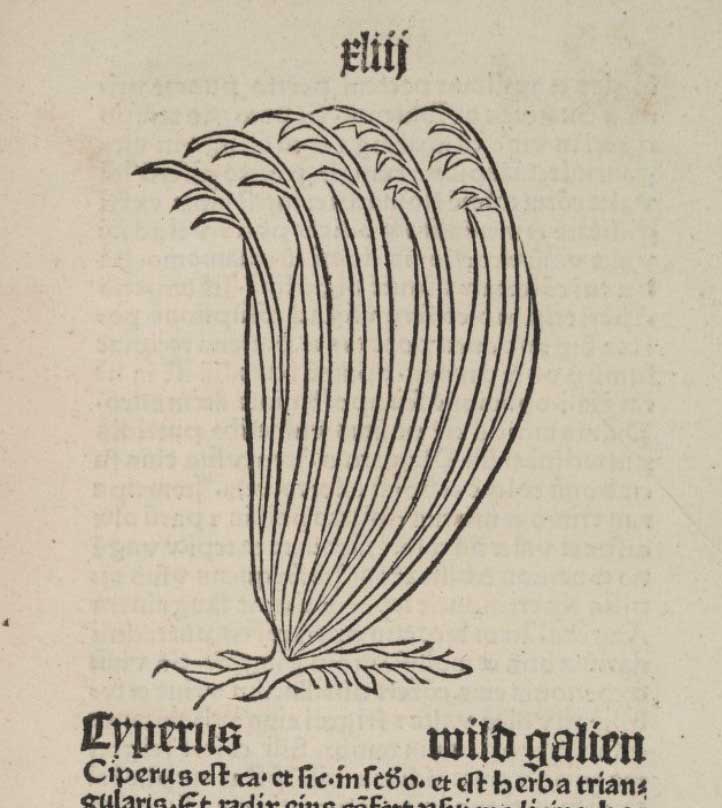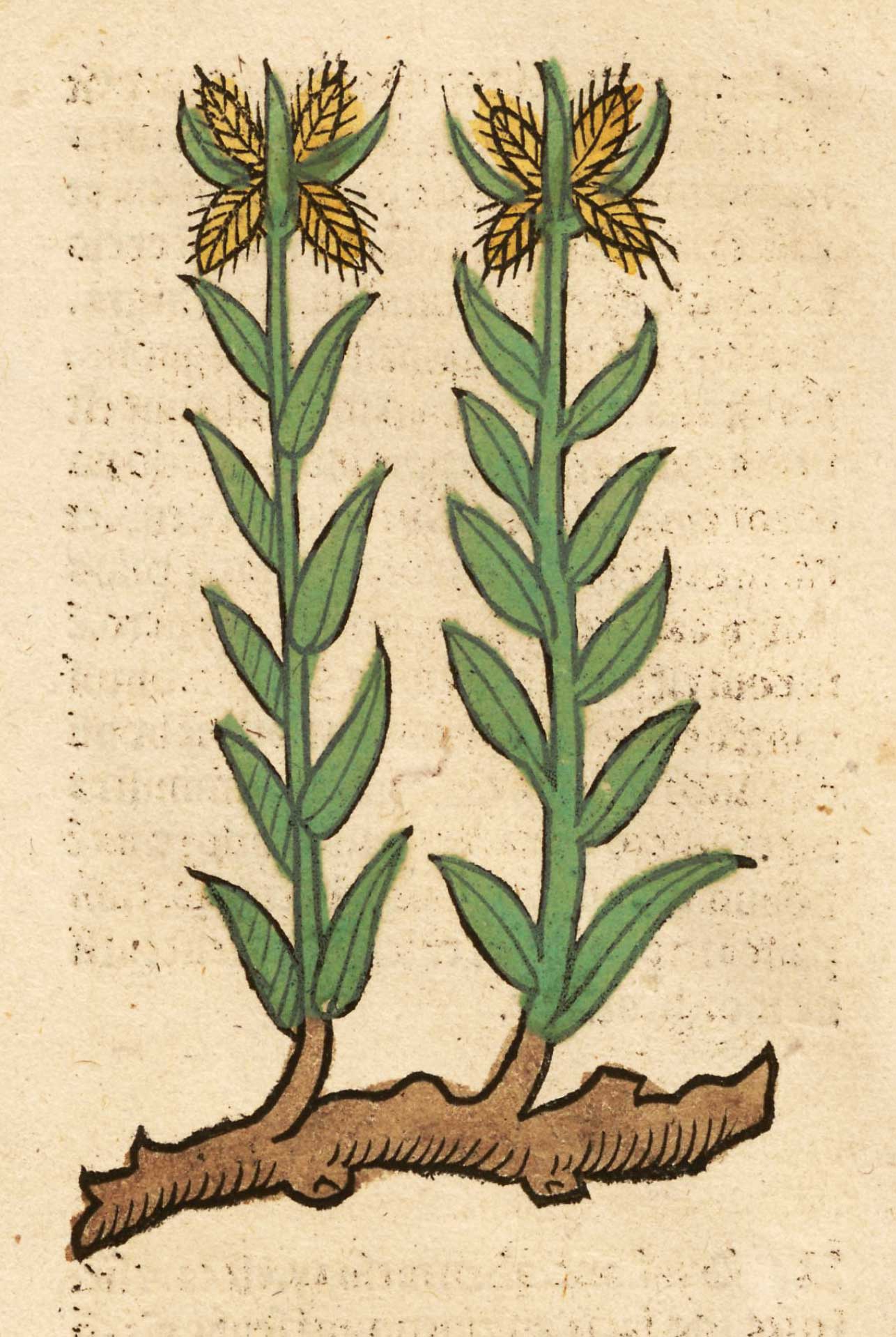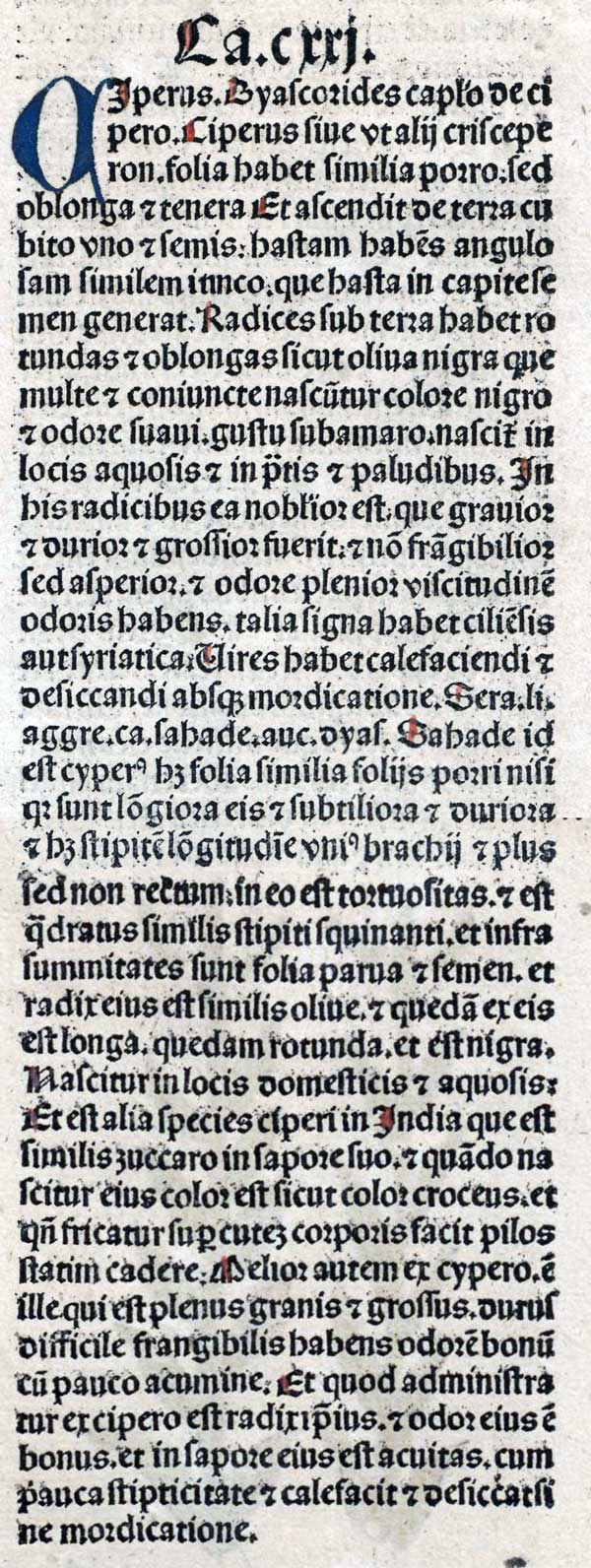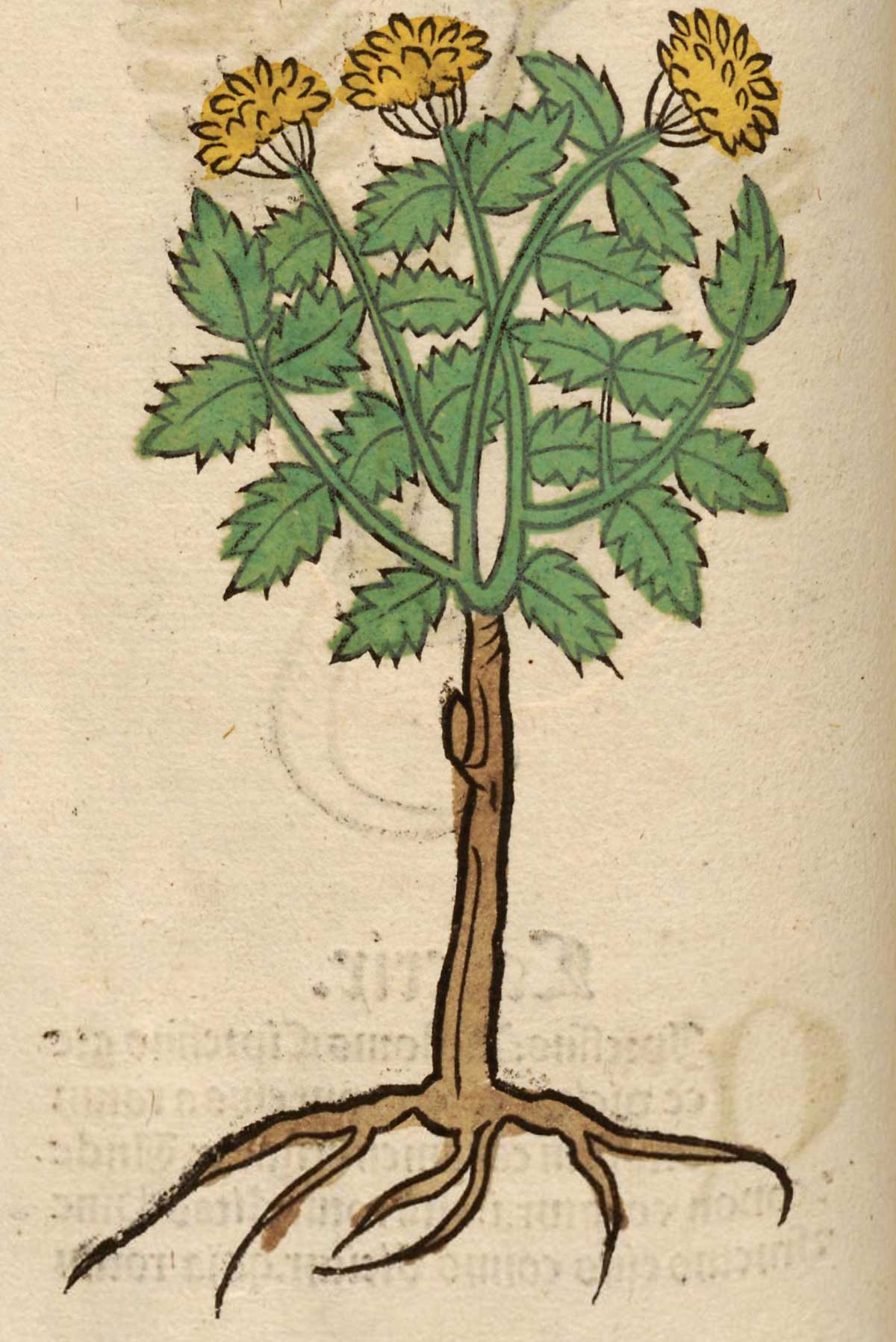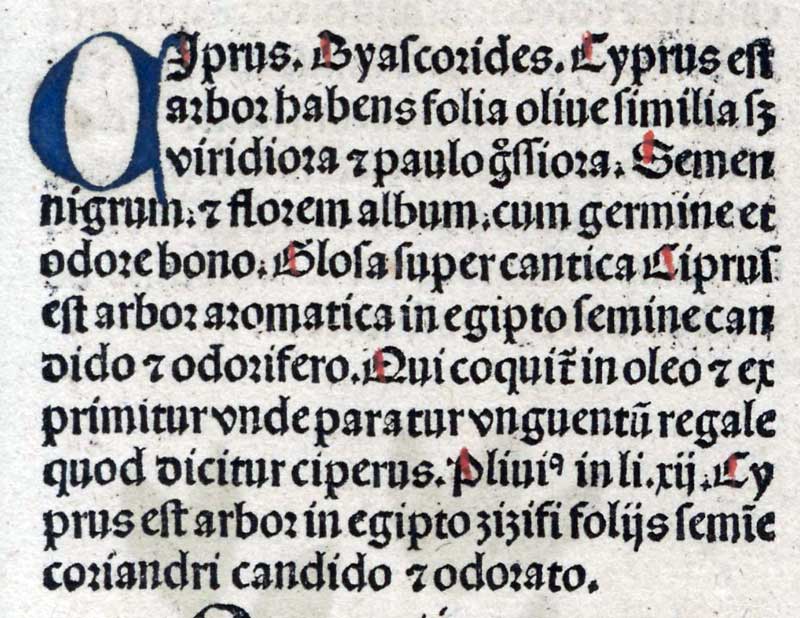Among the plants that, like Pantagruelion, have two sexes.
Notes
Cyperus
Cyperus
Cyperus (text)
Cyprus
Cyprus (text)
cypres
Pline, XVI, 60, décrit deux espèces de Cyprès : « Meta in fastigium convoluta, quæ et femina appellatur ; mas spargit extra se ramos. » Le C. femina est notre Cupressus fastigiata D. C.; le C. mas, notre C. horizontalis Mill., mais ces espèces sont toutes deux monïques. (Paul Delaunay)
cypres
Cupressus advena et difficillime nascentium fuit, ut de qua verbosius saepiusque quam de omnibus aliis prodiderit Cato, satu morosa, fructu supervacua, bacis torva, folio amara, odore violenta ac ne umbra quidem gratiosa, materie rara, ut paene fruticosi generis, Diti sacra et ideo funebri signo ad domos posita. femina
duo genera earum: meta in fastigium convoluta, quae et femina appellatur; mas spargit extra se ramos deputaturque et accipit vitem. utraque autem immittitur in perticas asseresve amputatione ramorum, qui xiii anno denariis singulis veneunt, quaestuosissima in satus ratione silva; vulgoque dotem filiae antiqui plantaria ea appellabant. huic patria insula Creta, quamquam Cato Tarentinam eam appellat, credo, quod primum eo venerit. et in Aenaria succisa regerminat; sed in Creta quocumque in loco terram moverit quispiam, nisu1 naturali haec gignitur protinusque emicat, illa vero etiam non appellato solo ac sponte, maximeque in Idaeis montibus et quos Albos vocant summisque in iis unde numquam nives absunt plurima, quod miremur, alibi non nisi in tepore proveniens et nivem magno opere fastidiens.
The cypress is an exotic, and has been one of the most difficult trees to rear, seeing that Catoa has written about it at greater length and more often than about all the other trees, as stubborn to grow, of no use for fruit, with berries that cause a wry face, a bitter leaf, and a pungent smell: not even its shade agreeable and its timber scanty, so that it almost belongs to the class of shrubs; consecrated to Dis, and consequently placed at the doors of houses as a sign of mourning. The female bears seed but the male is sterile [‘The female is sterile’; Mayhoff, comparing XVII. 73, marks a lacuna, and from § 247 conjectures the above insertion] . For a long time past merely owing to its pyramidal appearance it was not rejected just for the purpose of marking the rows in vineyards, but nowadays it is clipped and made into thick walls or evenly rounded off with trim slenderness, and it is even made to provide the representations of the landscape gardener’s work, arraying hunting scenes or fleets of ships and imitations of real objects with its narrow, short, evergreen leaf. There are two kinds of cypress: the pyramid, tapering upward in a spiral, which is also called the female cypress, and the male cypress which spreads its branches outward from itself, and is pruned and used as a prop for a vine. Both the male and the female are allowed to grow up so as by having their branches lopped off to form poles or props, which after twelve years’ growth sell for a denarius apiece, a grove of cypresses being a most profitable item in one’s plantation account; and people in old days used commonly to call cypress nurseries a dowry for a daughter. The native country of this tree is the island of Crete, although Cato calls it Taranto cypress, no doubt because that place was where it was first imported. In the island of Ischia also, if cut down, it will shoot up again; but in Crete this tree is produced by spontaneous generation wherever anybody stirs the earth, and shoots out at once, in this case in fact even without any demand being made of the soil and of its own accord, and especially in the mountains of Ida and those called the White Mountains, and in the greatest number on the very summits of the peaks that are never free from snow, which may well surprise us, as the tree does not occur elsewhere except in a warm climate and has a great dislike for snow.
cypress
cypress. Forms: ciprese, cypris, sypres,cipris, cipres, cypres, cipriss, -ys, cyprys, syprees, -ese, cupresse, cipresse, cypresse, cipreis, cyparesse, syprys, cypers, cipress, cypress. [Middle English cipres, cypres, etc., adopted from Old French ciprès (12th century), cypres, adaptation of late Latin cypressus (Vulgate, Isidore, etc.), adaptation of Greek kuparissoj cypress. The earlier Latin adaptation of the word was cupressus; the later cypressus and rare cyparissus were refashioned after Greek.]
A well-known coniferous tree, Cupressus sempervirens, a native of Persia and the Levant, extensively cultivated in Western Asia and Southern Europe, with hard durable wood and dense dark foliage; often regarded as symbolic of mourning (see c). Hence, the English name of the genus.
A. 1300 Cursur Mundi (The Cursur of the World) 1377 (Cott.) Cedre, ciprese [v.r. cipres, cipris], and pine.
A. 1400 Pistill of Susan 69 Þe sauyne and sypres, selcouþ to sene.
1513 Douglas Æneis iii. x. 47 The cipres berand hych thair bewis.
1551 William Turner A new herball i. (1568) N iij b, The lefe of Cypres neuer falleth, but is euer grene.
1616 Bullokar, Cypresse, a tree… very tall and slender, the tymber whereof is yellowish and of a pleasant smell.
1797 Mrs. Radcliffe Italian vi, A garden, shaded with avenues of melancholy cypress.
1872 Oliver Elem. Bot. 247 The wood of Cypress… is almost imperishable; the gates of Constantinople made of this wood lasted 1,100 years.
The wood of this tree.
A. 1300Cursur Mundi (The Cursur of the World) 8007 (Gött.) Þu sal find þa wandis þare, Of cydyr, pyne, and of cypress.
C. 1386 Chaucer Sir Thopas 170 His spere was of fine cipres.
1474 J. Paston Lett. No. 739 III. 110 My wryghtyng box of syprese.
1504 Bury St. Edmunds, Wills and inventories from the registers of the Commissary (1850) 98 My coffyr of syprys.
1621 Lady M. Wroth Urania 261 Into a coffer of Ciprus… he shut it vp.
1673 Philosophical Transactions of the Royal Society VIII. 6015 Another sort of wood, called Cypress… better than any Pine for Masts.
The branches or sprigs of the tree, used at funerals, or as a symbol of mourning. Also figurative.
1590 Edmund Spenser Faerie Queene ii. i. 60 The great earthes wombe they open to the sky, And with sad Cypresse seemely it embrave.
1591 Edmund Spenser Daphn. lxxvi, Vouchsafe to deck the same [a hearse] with Cyparesse.
1695 Prior Ode after Queen’s Death v, Let the King dismiss his Woes… And take the Cypress from his Brows.
1761 Sterne Tristram Shandy III. lxxv, ‘Tis one thing for a soldier to gather laurels,-and ’tis another to scatter cypress.
1850 Tennyson In Memoriam lxxxiv. iv, But that remorseless iron hour Made cypress of her orange flower.
Of cypress or cypress-wood. Resembling the foliage or shade of a cypress; cypress-like; dark, gloomy, funereal.
1596 Shakespeare Taming of the Shrew. ii. i. 353 In Iuory cofers I haue stuft my crownes: In Cypres chests my arras counterpoints.
1597 Lanc. Wills II. 228 A Cypresse chest standing in the like parlour.
1659 T. Pecke Parnassi Puerp. 67 Great was Macedo; but the Stagyrite, As much out shin’d; as bright Day, Cypress Night.
1870 Athenæum 19 Nov. 665 Plenty of cypress sentimentality in Kensal Green.
